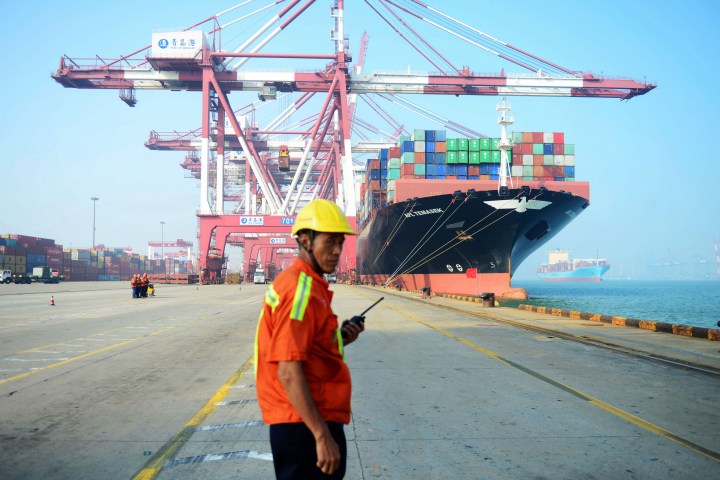
From semiconductors to containers, “every day, it’s a different problem” on the supply chain
From semiconductors to containers, “every day, it’s a different problem” on the supply chain

A growing list of shortages is wreaking havoc on global supply chains. From computer chips and lumber to aluminum and shipping containers, shortages are delaying deliveries and raising costs.
“Marketplace” host Kai Ryssdal spoke with India Hynes, CEO of Vinotemp, a custom wine cabinet manufacturer and luxury appliance distributor, about disruptions facing her company. The following is an edited transcript of their conversation.
Kai Ryssdal: Tell me, would you, the biggest challenge your company faces right now in terms of getting your product out to people who use it.
India Hynes: We cannot get container space on the vessels. Also, there is a chip shortage, so products are delayed, and we’re constantly getting price increases. Every day, it’s a different problem.
Ryssdal: Well, so there, let’s unpack that a little bit, and let’s start at the beginning, right? Containers coming out of — I’m assuming China is where they’re coming from — how do you get container space at a time when pretty much everybody on the planet is screaming for container space?

Hynes: Well, I don’t. That’s the big problem right now. So for example, last year, we paid something like $3,500 a container. Now we’re looking at $10,000 a container. And we are told if we pay a surplus, a $1,500-$2,000 surplus, we can get some space. So basically, we would be taking the space of someone else. So of course, I look at that as a shakedown, and then I get really mad. I’m like, “I’m not paying that.” So the two companies that are getting space right now, so I hear, are Amazon and Walmart. And I’m a little guy, so I’m last in line.
Ryssdal: Size matters. OK, so that’s containers. Talk to me about chips and semiconductors, and specifically, you know, we’ve all heard about cars and all those things that have a dozen or two chips in them. How many chips do your appliances need, and — this is a strong word — but is this an existential problem for you? Because this chip shortage is going to be around for a while.
Hynes: So when I first heard it, I kind of thought, “Oh, it’s just a moment.” Not like a freight problem, which is really, really a problem. So far, there is a delay on a few models, but my products are already delayed. So I think I’ll know more [about] the extent of this pain in about four months.
Ryssdal: That’s not a short amount of time, four months
Hynes: Yeah. The cycle of products now, where it used to be you order something, get something in 60 days, basically. Now you’re looking — I mean, I get emails saying, “Order now because it’s going to take six months to get your products.” I’m like, six months?! So it’s really difficult to try and provide proper inventory with this chain disruption.
Ryssdal: Right. Let’s get to the third item: price. This is costing you money, I’m sure. To what extent can you pass that on? Or are you eating it?
Hynes: OK, so we sell to top retailers, and the struggle we’re having-— first you get pushback. Then you’re like, I don’t have a choice, I have to pass it or there’s just no point in selling the product, you know, for breaking even or losing money. So it’s just kind of at that point where we raise it as much as we can. The problem is, [retailers] already raised [prices] in November, then we got the last month or so saying, “Raw materials, everything’s really expensive … copper is expensive,” blah, blah, blah, blah, blah. Of course, you know, I’m pushing back, delaying pulling the trigger on some of these orders. I’m just really trying to negotiate better pricing because I can’t go back to my retailers. They take 60 to 90 days to increase their pricing. So it’s really nuts on the supply chain right now.
Ryssdal: So look, what are you gonna do?
Hynes: Well, I’ve had to stop a lot of products that I wanted to test. I’ve had to put every new kind of item on hold and just really focus on what I know sells. Luckily for me, products that we were testing and that we might have stock of, all are selling through. So it’s actually almost like a spring cleaning, which that’s the positive part for me. So I’m not crying yet. I’m not happy with the product stuck, I need it. But all in all, we’ve managed this whole thing pretty well.
There’s a lot happening in the world. Through it all, Marketplace is here for you.
You rely on Marketplace to break down the world’s events and tell you how it affects you in a fact-based, approachable way. We rely on your financial support to keep making that possible.
Your donation today powers the independent journalism that you rely on. For just $5/month, you can help sustain Marketplace so we can keep reporting on the things that matter to you.

















